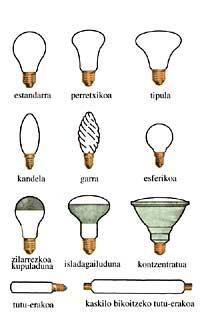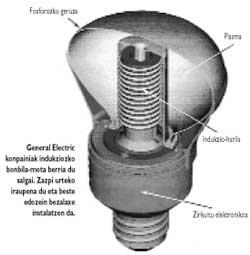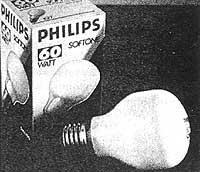The bulb forever: this is the sleeve!
1993/05/01 Mujika, Alfontso - Elhuyar Fundazioa Iturria: Elhuyar aldizkaria
The news was published last summer. An American company, "Intersource Technologies," claimed four winds: We have invented a revolutionary electric lamp for the home, without filaments or electrodes. Under normal working conditions it will work for 14 years and will only need a quarter of the electrical energy absorbed by conventional bulbs (incandescent lamps) to provide the same luminous flux.
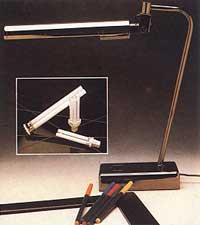
The news caused numerous media outlets. It seemed that the new product was going to revolutionize the industry of electric lamps overnight and turn them upside down. This new lamp is an induction lamp. Like all electric lamps, the electric energy is transformed into luminous energy, but for this it uses radio waves. The waves cause an electric shock in a mixture of gases inside the glass tube. Most of the physical and chemical reactions that deteriorate incandescent lamps (normal bulbs) and discharge lamps (fluorescent tubes, etc.) and finally deteriorate them, avoid induction lamps, separating the electrical components from the part of the lamp in which light is generated. It therefore modifies the technological basis of the lamp industry.
In principle, the idea of induction lighting is not new, but so far an economically competitive induction lamp has not been achieved in the market. The problem is that a radio transmitter with enough power to produce light in a mixture of gas in a glass tube emits long waves that interfere with television signals and others such as pacemakers. To limit or eliminate these emissions, expensive electronics or physical covers are needed. For example, Philips has launched an induction lamp two years ago, but it is very expensive: 70,000 sts. (3,500 volumes) are valid for each lamp and of great power, so they are not valid for domestic use. These lamps have started to be used in road tunnels due to the high cost of their replacement.
The Californian company seems to have devised an economic system to solve the problem of the interferences, with a price of 1.100-2.000 pts. (55-100 vol.) has announced that it will be the medium.
Is the revolution true?
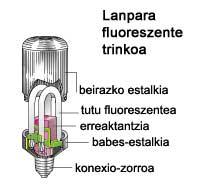
The lighting industry is researching induction technology and in general what it is doing is true. However, no one believes that conventional lamps are obsolete just by saying to Jesus amen. On the other hand, if someone believes that the lighting industry does not want to boost long-lasting lamps and that pockets are filled with face throwing short-lived lamps, he is completely wrong. The lighting technology is in continuous renewal in four areas: light efficiency (i.e. increasing the luminous flux of the lamp without increasing the absorbed electrical power), lamp life, aesthetics and, finally, price. In other words, the performance of the lamps is increasing, they last longer, they are getting smaller and more beautiful, and increasingly cheaper.
But what do the average consumer look at when buying the lamp? Aesthetics and price, which leaves in the background the luminous efficiency and the duration. Therefore, conventional bulbs (incandescent lamps with tungsten filaments) are the most commonly used in homes. On the contrary, efficiency prevails in public lighting. That is why low-pressure sodium lamps are used in streets and roads, although they provide low and yellow light.
And always what bulbs?
The design of the traditional bulb has not changed much since Thomas Alva Edison patented more than 100 years ago. Through a filament, surrounded by an inert gas, the electric current is passed heating the filament until its elevation (up to 2,500 °C in normal light bulbs of the house). These lamps are very cheap and easy to manufacture, but have two big defects: 1) Only 10% of the electrical energy they absorb is transformed into luminous energy.
The rest is spent heating the lamp. 2) The average duration is only about 1000 hours. The duration can increase if the filament is heated slowly, due to microscopic errors in the crystalline structure of the rapidly heated filamentous metal. By pressing the switch there are devices that progressively increase the electrical voltage in the filament, but they are expensive and are not profitable.
Halogen lamps
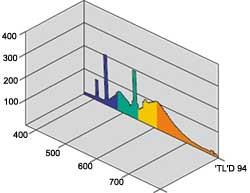
However, there have been innovations in the incandescent lamp field. In the 1960s there was a significant advance in the duration and luminous efficiency with the appearance of wolfram/halogen lamps. The higher the filament temperature, the more light it gives. However, overheating of the filament in conventional lamps causes the fractions of tungsten to evaporate and then accumulate forming a dark layer inside the bulb. Then the lamp emits less light and also the filament thins, that is, it breaks before.
At the end of the 1950s, the researchers discovered something surprising: if we add a bit of halogen to the inert gas inside the bulb, the gas reacts with the evaporated wolfram that escapes the filament forming a metal halide, which is located in the coldest parts of the filament. This “halogen cycle” has allowed the manufacture of a longer filament, which allows a higher temperature, that is, a lamp of greater light efficiency.
The current efficiency of halogen lamps is double that of conventional lamps and 3 (?) last longer times. But they are more expensive.
Discharge lamps
The area of discharge lamps is the most developed by the lighting industry. In these lamps the light is generated by the excitation of a gas or steam by an electric shock. The efficiency of these lamps is much greater than that of incandescent: The normal watts and incandescent emit more than 200 feathers, only 12. They also last much longer. But not all are advantages. These lamps are very efficient, but have a wide spectrum of colors.
For example, sodium lamps give a lot of light, but the light is yellow, not white. In addition, unlike incandescent, the total luminous intensity is not reached abruptly: they need a “heating time”. On the other hand, for the maintenance of the electric arc a control circuit is required, that is, the lamp needs a device next to the one that needs space and that increases the lamp. Finally, it should be noted that such lamps can hardly be manufactured at a nominal power of less than 150 watts. Consequently, they cannot be used in homes, offices, shops, etc. of small volume, as they provide an excess of light.
However, the lighting industry has constantly tried to overcome the drawbacks of these lamps. The result is the fluorescent lamps we all know, with an efficiency of 80-90 lumens per watt. They are mercury vapor discharge lamps. In the discharge tube is the mercury vapor mixed with cripton and argon. The tube is made of glass and its inner surface is covered by a layer of phosphorus powder. In the environment of this mixture of gas and steam, the electric discharge produces green and blue radiation, but above all invisible ultraviolet radiation for the human eye.
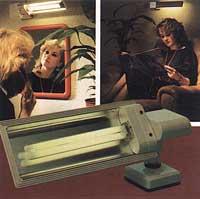
The powdered phosphorus layer absorbs ultraviolet radiation and expels it as visible wavelength radiation. This, mixed with blue and green radiation, seems to give white light. Depending on the phosphorus powder used, this color will be obtained. However, the color of the light obtained is somewhat farther from the color of daylight than that of incandescent lamps. In the scale of obtaining the “quality” of light, incandescent lamps have a value of 100, that is, daylight, and conventional fluorescent tubes between 55 and 90.
The latest novelty in discharge lamps are the high-intensity discharge lamps marketed a few years ago, which provide high efficiency and a “natural” light color. The efficiency of these lamps is 6 times greater than that of the conventional bulb. But the minimum manufactured power is 150 watts. This provides a luminous intensity of 12,000 lumens, too large for domestic and similar uses. In addition, it is expensive: almost 9,000 ptas. (450 vols.) Valid. Therefore, these types of lamps can only be used in shop windows and the like.
And why change the bulb always?
Why are these new lamps so expensive? Because they have a difficult manufacturing process. Chemical compounds must be mixed in very small and precise quantities, controlled by computer and in very special conditions. Therefore, in the lighting industry nobody believes for the moment that no lamp will replace the traditional bulb in our homes.
However, with this objective another type of lamps has been enabled: the compact fluorescent lamp, marketed about 8 years ago. The lighting industry has invested billions in the development and marketing of this lamp. What is right? On the one hand, for the same light intensity, it absorbs between 4 and 5 times less electric energy than the conventional bulb. On the other hand, it lasts between 6 and 8 times longer than the conventional pump. They are small and compatible, that is, they can replace the conventional bulb (not always, to tell the truth) because they connect in the same house of lamps. As for the color of light, the new phosphorus powders found allow obtaining good light: 85 on a scale of 100.
The advantages of such lamps are therefore evident. But normal consumers don't use this type of argument. 3,000 ptas (150 vols). More than pay once and forget the long lamp, 125 sts. (6 vols.) We prefer to buy conventional bulbs of value without stopping and pay more to the electric company. We waste energy and money as seen in the box above. The excuses are easy to find: they have ugly shape, at first you have to pay a lot, they do not always serve to change...
The compact lamp still removes the small part of the market from the traditional bulb. In addition, about 70% of the compact lamps sold are used in industry and not in homes.
If you have already had limited success, now it seems that you will see a tough competitor, the induction lamp we mentioned at the beginning of the article. Therefore, trade war could soon begin between compact lamps and induction lamps. In this hypothetical battle, in addition to prices, duration and efficiency, it is easy to detect that “green marketing” will be used, which is now in full swing in industrial products. Ecology is sold.
Therefore, they want to sell us “greenery”, saying that this lamp is greener than the other. But be careful! Greenness is not measured only by energy consumption. Each compact fluorescent lamp contains 12 milligrams of mercury, very toxic. In addition, the manufacturing process of these complex circuits with induction lamps is harmful to the environment. In this sense, the incandescent lamp with conventional tungsten filament, the bulb of always, despite being a waste of energy, should be said to be “greener” than its competitors.
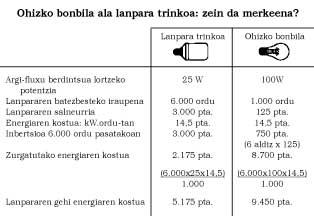
(Note: To see the photo well go to pdf).
Incandescent
Halogen Lamps
Fluorescent Tubes
Compact Fluorescent Induction
Lamps
22
80
50
1.000
6.000
6.000
euros
of
outstanding

Gai honi buruzko eduki gehiago
Elhuyarrek garatutako teknologia




